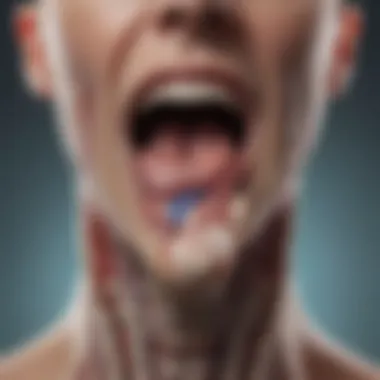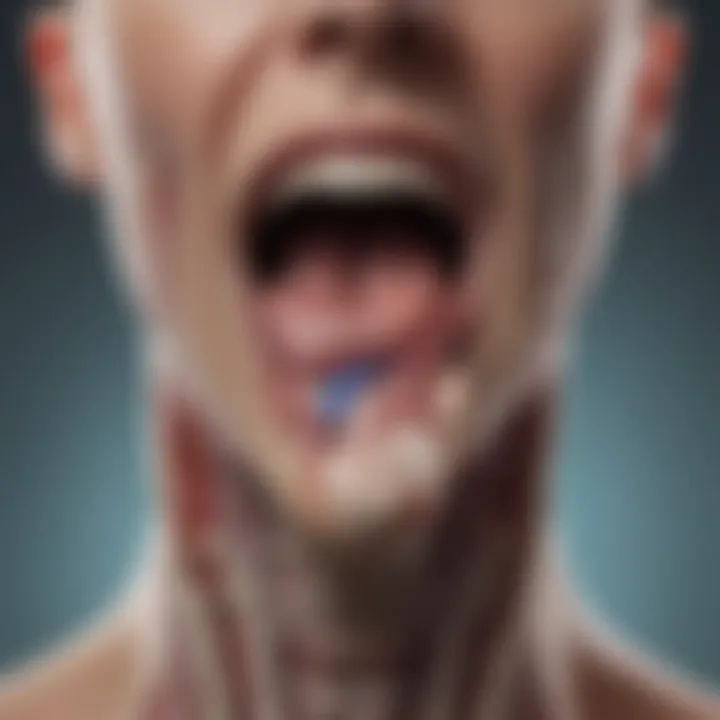Managing Dysphagia After Radiation Therapy


Intro
Dysphagia, or difficulty in swallowing, is a condition that many may not recognize as a significant aftermath of radiation therapy, especially for patients undergoing treatment for head and neck cancers. The muscle control and sensation required for swallowing can be severely compromised, leading not only to physical discomfort but also to substantial declines in quality of life. For those on the front lines of patient care—be it healthcare practitioners, researchers, or even patients themselves—this complication warrants deeper understanding and proactive management.
In this article, we will uncover the mechanisms that contribute to dysphagia post-radiation therapy, delve into the impact of this condition on patients' lives, and explore diagnostic and management strategies that can enhance overall well-being. Our aim is to shed light on this often neglected issue, highlighting its significance and encouraging improved approaches to care.
Key Findings
Despite being a common occurrence, dysphagia following radiation therapy remains underreported and misunderstood. Recent studies have revealed several critical insights:
- Major Results:
- Discussion of Findings:
- A significant proportion of patients receiving radiation for head and neck cancers experience varying degrees of swallowing difficulties, with some studies indicating rates as high as 50% or more.
- The severity of dysphagia can correlate with dose and volume of radiation therapy delivered to the swallowing structures.
- Advances in imaging and diagnostic techniques allow for better assessment and tracking of dysphagia over time.
- Patients often report a fear of choking or aspiration, which can lead to changes in eating habits and nutrition. This is not just discomfort; it can lead to serious health issues like malnutrition or dehydration.
- The psychological effects must also be acknowledged; patients may experience isolation or depression due to their inability to participate in social eating situations.
Methodology
Conducting a thorough examination of dysphagia related to radiation therapy involved comprehensive research strategies:
- Research Design:
- Data Collection Methods:
- This study employed a mixed-methods approach, blending quantitative data from clinical assessments with qualitative insights gathered from patient interviews.
- Clinical data was collected through swallow tests and imaging studies, while patient perspectives were garnered through interviews focusing on personal experiences and challenges associated with dysphagia.
Through a detailed understanding of both clinical outcomes and personal narratives, healthcare providers can tailor interventions more effectively to meet patients' unique needs.
As we continue this discussion, it is essential to integrate insights from the latest research and clinical practices. Understanding dysphagia is not merely an academic exercise; it is a pivotal step towards enhancing patient care and improving lives.
Foreword to Dysphagia and Radiation Therapy
Dysphagia, which refers to difficulty in swallowing, is more than just a nuisance for individuals undergoing radiation therapy. It can profoundly affect a patient's quality of life, complicating treatment outcomes and recovery. Understanding dysphagia in the context of radiation therapy, particularly for those battling head and neck cancers, is vital. This knowledge enables healthcare practitioners to better anticipate, identify, and manage the symptoms effectively.
The significance of this topic is underscored by the incidence rates of dysphagia following radiation treatment, which range notably, depending on the specific medical and anatomical circumstances. Fostering awareness is key, not merely for patients, but also for caregivers and medical professionals who often overlook this debilitating condition. Incorporating dysphagia into the conversation can lead to more robust treatment plans and holistic patient care.
Understanding Dysphagia
Dysphagia is a complex process and can manifest in several ways. A patient might experience mild discomfort or complete inability to swallow comfortably, which can have roots in both muscular and neurological dysfunctions. The swallowing process involves an intricate orchestration of nerves and muscles, and disruption at any stage—whether in preparation, transit, or the swallowing phase—can lead to significant difficulty. Recognizing the symptoms and understanding their progression can guide timely intervention, which is essential for patient well-being.
In practical terms, dysphagia may also induce fear of eating and drinking, creating a cycle of social withdrawal. Patients might avoid meals altogether, leading to nutritional deficiencies,” says Dr. Jane Doe, a speech-language pathologist at the local hospital.” The emotional toll, combined with the appetite-loss symptoms, can drive patients into isolation at a time when support from friends and family can be crucial.
Overview of Radiation Therapy
Radiation therapy, primarily used in the treatment of malignancies, employs high-energy particles or waves to destroy or damage cancer cells. While effective, the procedure often incurs side effects, with dysphagia being a common complication observed in patients. The radiation may affect the salivary glands, muscles, and nerves involved in the swallowing process, further exacerbating difficulties.
Understanding the types of radiation therapy is crucial as well. External beam radiation therapy, used frequently for head and neck tumors, can lead to more pronounced dysphagia due to the proximity of vital structures involved in swallowing to the affected area. On the other hand, brachytherapy, which is a form of internal radiation, may present different challenges.
The balance between treating cancer effectively and managing the side effects of that treatment is delicate. Thus, ongoing communication among oncologists, speech therapists, and dietitians is vital to develop comprehensive care strategies that consider the physical, emotional, and nutritional needs of patients.
Pathophysiology of Dysphagia Post-Radiation
Understanding the pathophysiology behind dysphagia following radiation therapy is essential to grasp the nuances of this condition. It is not just about recognizing symptoms but delving deep into how radiation alters bodily functions, especially in individuals undergoing treatment for head and neck cancers. Knowing these underlying mechanisms can aid healthcare practitioners in formulating targeted interventions, thereby improving patient outcomes.
Mechanisms of Swallowing Difficulties
The act of swallowing is a complex process involving multiple stages, including the oral, pharyngeal, and esophageal phases. Dysphagia can occur at any of these stages post-radiation. One of the primary mechanisms contributing to these difficulties is the impact of radiation on nerve function. The radiation can damage the cranial nerves responsible for coordinating swallowing, leading to disrupted signals and spasms. This disruption translates to difficulties in moving food from the mouth to the esophagus.
Additionally, muscle weakness is a significant factor. The muscles involved in swallowing can become weak or fatigued due to radiation-induced changes. This weakness hinders the normal propulsion of food, causing aspiration or choking hazards in severe cases.
Furthermore, inflammation plays a role. After radiation therapy, inflammation can occur in the tissues of the throat, narrowing the diameter through which food must pass and making swallowing a more laborious task. This intricate interplay of nerve damage, muscle fatigue, and tissue inflammation underpins many complaints of dysphagia in post-radiation patients.
Anatomical Changes in Affected Tissues
Post-radiation, the tissues in the affected area undergo significant anatomical changes. The mucosal surfaces of the throat and esophagus can become thickened and fibrotic as a result of radiation exposure. This leads to reduced elasticity and less ability to stretch, making it harder for food to move smoothly through the swallowing pathway. Such fibrosis can make the esophagus feel tight or constricted, resulting in a sensation often described by patients as "food getting stuck."


Moreover, there’s concern about the salivary glands, which can also be adversely affected. The reduced saliva flow due to damage diminishes lubrication necessary for swallowing, often making it uncomfortable. The change in these crucial structures can significantly impact the swallowing process and overall patient's comfort.
Physiological Changes Impacting Swallowing
The physiological consequences of radiation extend beyond just anatomical changes; they include alterations in sensation and motor control. Patients may experience altered taste or diminished sensation in the mouth and throat, which can lead to poor eating habits or avoidance of food altogether.
Moreover, patients may also encounter issues with the reflexes involved in swallowing. For example, the normal cough reflex can be impaired, preventing the immediate body response to aspirated food or liquids. This impairment can lead to serious complications, including aspiration pneumonia, which is prevalent among those who have undergone head and neck radiation.
The multidisciplinary approach required in managing dysphagia is influenced by these physiological issues. Understanding these changes highlights the necessity for healthcare teams to focus not just on the physical act of swallowing but also on addressing sensory alterations and ensuring safety during eating and drinking.
"Dysphagia affects more than just physical health; it impacts a person’s entire quality of life, encompassing their social interactions and emotional well-being."
Identifying Dysphagia After Radiation Therapy
Identifying dysphagia after radiation therapy is a critical aspect that cannot be overlooked. This condition often emerges subtly but can profoundly affect a patient's overall wellbeing. Recognizing dysphagia can lead to timely interventions which can improve the quality of life for numerous survivors who are trying to navigate the aftermath of their treatment.
Dysphagia encompasses not just the physical act of swallowing but extends into the emotional and social realms. It is important for clinicians to be attuned to the signs. Early detection can prevent significant complications such as malnutrition or aspiration pneumonia, improving the chances of effective rehabilitation.
Clinical Presentation of Dysphagia
When examining the clinical presentation, it's vital to consider a range of symptoms that can manifest in patients. Many individuals might report a sensation of food getting stuck in the throat, which can lead to fear and avoidance of eating. Others may experience pain during swallowing, known as odynophagia, indicating potential inflammation or other underlying issues.
Some common clinical signs include:
- Choking or coughing during meals.
- Decreased appetite or weight loss.
- Regurgitation of food after swallowing.
- Changes in voice or gurgly sound when speaking.
This array of symptoms can lead to significant disruptions in dietary habits, and awareness amongst healthcare professionals is a key step in mitigating the impact of dysphagia.
Diagnostic Methods for Evaluation
To accurately evaluate dysphagia, a thorough diagnostic process is essential. Clinicians must employ a variety of assessment tools. The evaluation journey often begins with a detailed medical history and a physical examination. Next, healthcare professionals may utilize specific diagnostic methods, such as:
- Videofluoroscopic swallow study (VFSS): This X-ray procedure helps visualize the swallowing process.
- Fiber-optic endoscopic evaluation of swallowing (FEES): A flexible endoscope allows direct observation of the swallowing structure.
- Manometry: This evaluates the pressure in the esophagus and can shed light on motility disturbances.
These methods not only provide insight into the mechanics of swallowing but also guide treatment decisions. Identifying the specific nature and cause of dysphagia is crucial.
Severity Assessment and Classification
Assessing the severity of dysphagia is indispensable for tailoring effective treatment regimens. A multi-tiered classifier can help in this task. This classification generally revolves around both the degree of functional impairment and the underlying pathology.
Severity might be categorized as follows:
- Mild: Occasional difficulty, but not consistently; minimal dietary restrictions.
- Moderate: Frequent difficulty swallowing, necessitating changes in diet consistency or assistance during meals.
- Severe: Persistent and significant swallowing difficulties requiring specialized diets, potential feeding tubes, or higher levels of care.
"Assessing dysphagia severity opens pathways to targeted interventions, enhancing patient experiences and outcomes."
Identifying and possessing a structured approach to dysphagia post-radiation therapy can not only improve immediate clinical care but also enhance long-term recovery strategies. Through vigilant observation and comprehensive assessment methods, practitioners can significantly mitigate the burdens imposed by this often-overlooked complication.
Impact of Dysphagia on Quality of Life
Dysphagia, or difficulty in swallowing, is more than just a medical term; it can throw a wrench in the daily lives of those affected. For patients who have undergone radiation therapy, particularly targeting the head and neck, this condition often sneaks up, like an uninvited guest at a party. Recognizing the impact of dysphagia on quality of life captures the broader implications of this complication and underscores its significance in the overall patient experience. Addressing the multifaceted nature of dysphagia can lead to better recovery plans and tailored supportive care, ultimately enhancing the well-being of patients.
Physical Implications
The physical burden of dysphagia is concrete and can manifest in ways that are hard to ignore. Patients might experience pain while swallowing, or feel like they are choking on food or liquid. Each meal can transform into a dreaded affair, where anxiety overshadows appetite. It's not just unpleasent; over time, this struggle can lead to weighing downs, making it difficult to maintain the necessary energy levels for daily activities.
Some physical concerns include:
- Aspiration pneumonia: When food enters the lungs instead of the stomach, it can cause serious infections.
- Dehydration: Reduced fluid intake means the body might not be getting the hydration it desperately needs.
- Oral health issues: Difficulty swallowing might lead to poor oral hygiene, increasing the risk for cavities or infections.
Patients often find themselves stuck between two rocks: the discomfort of swallowing and the need for nourishment. Clearly, this creates a cycle that goes beyond just physical discomfort and starts to influence psychological well-being.
Psychosocial Effects
The social dynamics around eating can also tilt dramatically due to dysphagia. Dining, which is typically a communal and enjoyable experience, may become a source of distress and embarrassment. Friends and family might not know how to provide support or might feel helpless when watching a loved one struggle. This often results in social isolation, as patients might start to avoid eating in public or skip meals altogether, leading to feelings of loneliness.
The emotional toll shouldn't be overlooked. Patients may experience:


- Anxiety: Just the thought of eating could trigger anxiety attacks.
- Depression: Prolonged discomfort combined with social withdrawal can send many into a downward spiral.
- Frustration: Not being able to enjoy something as basic as a meal can be a hard pill to swallow, both mentally and emotionally.
Addressing these psychosocial issues requires a holistic approach, incorporating emotional support along with physical treatments.
Nutritional Impact
When it comes to nutrition, dysphagia can act as a double-edged sword. As patients struggle to eat, they may not be able to consume the nutrients they need to heal and regain strength. The importance of caloric intake can’t be overstated. Without a balanced diet, energy levels plummet, which can prolong recovery times and, in some cases, complicate the initial condition that led to the radiation therapy.
Several nutritional challenges arise:
- Malnutrition: Limited food intake can lead to serious deficiencies in vital nutrients.
- Weight loss: Many patients notice a decline in weight as their bodies fail to get adequate nourishment.
- Altered taste: This can make eating even less appealing, further complicating dietary needs.
- Need for specialized diets: Patients may require calorie-dense supplements or modified textures, which can be difficult to manage.
The integration of dietary modifications must be tailored uniquely to each patient to improve their dietary intake and manage symptoms effectively.
In summary, dysphagia carries significant physical, psychosocial, and nutritional ramifications. Recognizing these impacts is crucial for healthcare professionals and caregivers, prompting a thoughtful approach to managing dysphagia and improving quality of life for affected individuals.
Management Strategies for Dysphagia
Dysphagia is not just a clinical term signifying difficulty swallowing; it carries profound implications for a patient’s daily life, well-being, and dignity. Managing dysphagia effectively ensures that patients undergoing radiation therapy, particularly for head and neck cancers, regain a level of comfort and autonomy. This section highlights various strategies to address dysphagia post-radiation, emphasizing the holistic approach necessary to improve patient outcomes.
Initial Assessment and Referral
The first step in managing dysphagia is a thorough assessment. This often starts with healthcare professionals identifying symptoms such as coughing during meals, sensation of food getting stuck, or painful swallowing.
A comprehensive evaluation typically invloves:
- Patient History: Detailed inquiries about the onset, duration, and nature of swallowing difficulties.
- Physical Examination: Observation can reveal clues about muscle function and oral health.
- Referral to Specialists: In many cases, collaboration with a speech and language pathologist is crucial. They can conduct formal assessments like the Videofluoroscopic Swallowing Study (VFSS) to identify specifics of the swallowing process. Referral criteria may include:
- Persistent or worsening swallowing difficulties
- Significant weight loss or dehydration
Therapeutic Interventions and Rehabilitation
Once dysphagia is diagnosed, tailored therapeutic interventions come next. The rehabilitation program should focus on:
- Swallowing Therapy: Techniques taught by speech and language therapists can include exercises to strengthen muscles involved in swallowing. These may range from simple bolus manipulation to complex maneuvers that improve coordination.
- Postural Techniques: Adjusting body position during meals can significantly enhance swallowing function. This might include chin tuck, head turn, or side-lying positions depending on the specific deficits presented.
- Neuromuscular Electrical Stimulation (NMES): For some patients, NMES can help facilitate improved muscle function and control, although the evidence varies on its efficacy.
Nutritional Support and Dietary Modifications
Nutritional risks often accompany dysphagia. A dietary review can yield adaptations that ensure adequate nutrition while maximizing swallowing safety. Strategies may include:
- Texture Modifications: Altering food consistency can make meals more manageable. Soft, moist foods or puree-based diets may be necessary.
- Hydration Management: Liquids might require thickening agents to prevent aspiration. Different thickening levels can help patients adjust to their swallowing capabilities.
- Meal Planning: Working with a registered dietitian can guide meal planning that aligns with an individual’s caloric needs while respecting their swallowing limitations.
Use of Assistive Devices
For some individuals, assistive devices can significantly improve their eating experience:
- Cutlery and Dishware: Adapted forks and spoons with unique grips make self-feeding easier.
- Modified Cups: Specialty cups can help control liquid flow, reducing the risk of aspiration.
- Palate Shields: These devices can aid in providing stability and safety during swallowing, especially for those with severe oral and pharyngeal challenges.
Integrating Assistive Devices Into Daily Life: It’s essential for patients to receive guidance on effectively using these tools to maintain independence during meals.
Supportive Care in Managing Dysphagia
Dysphagia, the medical term for difficulty swallowing, often emerges as a significant concern in individuals who have undergone radiation therapy, especially those targeted for head and neck cancers. While medical intervention and rehabilitation strategies play a vital role in management, supportive care in the context of dysphagia cannot be overstated. It lays the groundwork for not only improving swallowing function but also enhancing the overall quality of life for patients.
Supportive care encompasses a comprehensive approach that addresses the physical, emotional, and nutritional needs of patients facing the challenges of dysphagia. By focusing on building a robust support network and integrating various therapies, healthcare professionals can create an environment conducive to healing and adjustment.
Role of Speech and Language Pathologists
Speech and Language Pathologists (SLPs) are pivotal players in the team managing dysphagia. Their expertise lies in assessing and diagnosing swallowing disorders. They assist patients in regaining their ability to swallow safely and effectively. SLPs employ a range of assessments, including clinical swallowing evaluations and instrumental assessments like the Modified Barium Swallow Study.
One key point is that SLPs design tailored therapeutic exercises and strategies, enabling individuals to navigate their swallowing issues thoughtfully. They provide education on safe swallowing techniques, dietary modifications, and the importance of posture during meals. Their involvement is crucial, not just for treatment but also for empowering patients with knowledge to manage their condition.
"Continuous collaboration between patients, SLPs, and other healthcare professionals significantly contributes to better swallowing outcomes."
Integrating Palliative Care Approaches
Palliative care approaches can also be interwoven into the management of dysphagia, particularly for patients experiencing advanced stages of cancer. The focus here goes beyond merely addressing the symptom of swallowing difficulties; it prioritizes the patient's comfort and dignity throughout their treatment journey.


This interdisciplinary approach involves collaborative communication among oncologists, nutritionists, SLPs, and palliative care specialists. Together, they can create tailored interventions to manage symptoms and enhance patient comfort.
Key aspects of palliative care include:
- Pain Management: Ensuring patients are pain-free can significantly affect their ability to swallow and their overall willingness to eat and drink.
- Emotional Support: Addressing psychological distress through counseling and support groups can provide emotional resilience, aiding the coping process.
- Family Involvement: Engaging family members in care discussions ensures that the social and emotional needs of patients are also acknowledged.
Recent Advances in Management Techniques
In the realm of dysphagia following radiation therapy, recent advances in management techniques represent a beacon of hope for both patients and healthcare practitioners. The complexities associated with this condition demand a multifaceted approach. As research progresses and innovative methods emerge, the focus shifts towards enhancing patient outcomes and improving the overall quality of life.
One key development in this area is the push for personalized care plans. By tailoring interventions to individual patient needs, clinicians can better address specific swallowing difficulties encountered after treatment. This client-centered attitude not only delights practitioners but also fosters a deeper bond with patients, making them feel valued and understood.
"Every patient is unique; it’s our job to craft a solution that suits their specific needs."
Innovative Therapies and Techniques
Recent innovations in therapies are making significant strides in managing dysphagia post-radiation. One such breakthrough involves the application of neuromuscular electrical stimulation (NMES). This technique provides targeted stimulation to the muscles involved in swallowing, aiding in their rehabilitation. Studies have shown promising results, with many patients reporting improved swallowing function and reduced choking incidents.
Another noteworthy therapy is the use of swallowing exercises guided by speech-language pathologists. These exercises, such as the Mendelsohn maneuver or the effortful swallow technique, have gained traction in rehabilitation programs. Not only do they strengthen muscles involved in swallowing, but they also enhance coordination, ultimately paving the way for more effective swallowing.
The Role of Technology in Treatment
Technology has begun to play a pivotal role in the management of dysphagia following radiation therapy. Advanced imaging techniques, such as video fluoroscopic swallow studies, allow for precise visualization of swallowing mechanics. This precision aids clinicians in diagnosing specific issues and crafting targeted treatment plans.
Moreover, mobile applications designed for dysphagia management have entered the scene. These applications often provide reminders for exercises, dietary guidelines, and even video demonstrations of therapeutic techniques. Such user-friendly tools can empower patients in their recovery journey, making it easier for them to adhere to treatment regimens and track their progress.
Also, telehealth has emerged as a revolutionary approach, allowing for remote consultation with specialists. While distance once presented a challenge, emerging technology facilitates vital follow-ups and consultations without the need for patients to travel. This becomes especially valuable in managing ongoing symptoms, ensuring patients receive timely support from healthcare providers.
Research Trends and Future Directions
Understanding the implications of dysphagia following radiation therapy is crucial for improving the management of this condition. As the medical field continues to evolve, staying abreast of research trends offers exciting prospects for patient treatment and well-being. This section discusses current studies and identifies potential areas that could warrant further exploration.
Current Studies and Findings
Recent research has produced several findings that shed light on dysphagia’s underlying mechanisms after radiation therapy. One significant study published in The Journal of Clinical Oncology revealed that altered swallow function is not merely due to anatomical changes; biomechanical factors also play a significant role. Researchers initiated trials examining specific exercises aimed at improving muscular coordination in the throat, yielding promising results in enhancing swallow safety and efficiency.
Additionally, there’s an interesting correlation identified between the dose of radiation received and the severity of swallowing difficulties. A meta-analysis that surveyed multiple studies found that patients receiving high doses concentrated on the laryngeal and pharyngeal regions exhibited a higher incidence of dysphagia than those receiving lower doses. This insight emphasizes the need for tailored radiation treatment plans, perhaps integrating swallowing therapy concurrently.
Notably, recent technological advancements have led to improvements in the diagnostic process. Novel imaging techniques, paired with software for analyzing swallowing patterns, allow for more precise evaluations. More accurate assessments mean effective treatments can be administered quicker, which can potentially mitigate the glide into chronic dysphagia.
"Integrating innovative diagnostic methods not only enhances assessment but also paves the way for patient-centric interventions, empowering individuals in their healing journey."
Potential Areas for Future Research
While strides have been made in understanding dysphagia resulting from radiation, several areas remain ripe for exploration. One such avenue is the potential role of supportive therapies. To date, much of the emphasis has been placed on the physiological and anatomical impacts of radiation therapy, but less attention has been given to the psychological aspects. Research could examine whether psychological interventions, such as counseling or cognitive behavioral therapy, might improve outcomes for those struggling with swallowing.
Moreover, the integration of lifestyle factors into the management of dysphagia represents a frontier needing exploration. Studies focusing on how nutrition and physical activities influence dysphagia outcomes could provide additional guidance for treatment plans. For example, can specific dietary modifications early in treatment mitigate long-term swallowing issues? Also, how can an emphasis on general wellness contribute to better recovery prospects?
Another promising direction could be the role of interdisciplinary teams. While speech and language pathologists are often at the forefront of dysphagia management, collaborative research involving oncologists, dietitians, and psychologists could yield comprehensive approaches to care. The concept of shared knowledge and methods can enhance overall treatment efficacy.
Finally, addressing disparities in access to care remains crucial. Research aimed at understanding how socioeconomic factors impact dysphagia management can inform more equitable care strategies. Disparities could be reduced by exploring telemedicine solutions that provide remote assessments and consultations, ensuring patients in underserved areas receive timely support.
In summary, the landscape of dysphagia research is evolving, and several emerging trends warrant attention. Patients, caregivers, and healthcare providers can all benefit from increased research efforts aimed at understanding the multifaceted nature of dysphagia following radiation therapy.
Finale
In the intricate landscape of radiation therapy, the overlooked complication of dysphagia has significant implications for patient recovery and quality of life. The importance of addressing dysphagia cannot be overstated, as it often weaves itself through the fabric of a patient's post-treatment experience, affecting their ability to eat, communicate, and engage socially. Not only does it lead to physical discomfort, but it also presents emotional and psychological burdens that can amplify the challenges faced by individuals who are already navigating the taxing journey of recovery from cancer.
Summary of Key Insights
Dysphagia arises as a multi-faceted challenge post-radiation therapy, often underrecognized by healthcare providers. Understanding the various dimensions of this condition is crucial:
- Pathophysiology: Insight into how radiation alters the anatomy and physiology of the swallow mechanism is essential. Damage to the muscles and neural pathways can explain the swallowing difficulties that patients endure.
- Impact on Quality of Life: The implications of dysphagia extend beyond the act of swallowing. Difficulty in this basic function can lead to malnutrition, social isolation, and diminished life satisfaction. This condition should therefore be viewed through a holistic lens.
- Management Strategies: The importance of early identification and management cannot be stressed enough. Speech and language pathologists, nutritionists, and oncologists must collaborate to develop a tailored management plan that addresses not only the physical aspects but the emotional and social dimensions as well.
Call to Action for Healthcare Professionals
Healthcare professionals are at the frontline of combating the challenges posed by dysphagia in post-radiation patients. There are several actionable steps that can be embraced:
- Education and Awareness: It is vital for practitioners to educate themselves on the signs and symptoms of dysphagia, so they can recognize it early. Training should include both the physiological and psychological elements of dysphagia.
- Interdisciplinary Collaboration: Building a network with colleagues in nutrition, rehabilitation, and counseling can lead to a more rounded approach. This team should meet regularly to assess cases and share learnings, creating a supportive environment for patients.
- Patient Engagement: Encourage patients to communicate openly about their swallowing difficulties. Education empowers patients, helping them understand what interventions are available and why they are important.
"A comprehensive approach that emphasizes communication between patients and healthcare providers can significantly improve outcomes for those dealing with dysphagia."
By tackling dysphagia head-on, and recognizing the burdens it can impose, healthcare professionals can lead the charge toward improved quality of life and positive survivorship experiences for their patients. It is not just about prolonging life but enhancing its quality, fostering strength in the face of adversity, and addressing symptoms that might otherwise remain in the shadows.



